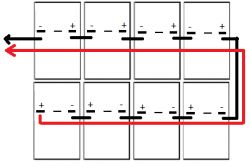Hello,
Conditions:
- 30 meters from the table to the inverter - it will be routed in the ground, I want to put it in a 75mm corrugated pipe so that in the future, when expanding, I can pull an additional pair of cables.
- 4mm? cable on modules - 16 modules contain a total of 38.4 meters of cable (2 × 1.2m per module according to the specification for the LR6-60HPH-315M module was supposed to be 2 × 0.3m)
- 22 meters extra cable for leveling loops on the table etc.
The above gives a total of 90.4 meters of solar cable, does it make sense to run the cable from the table to the inverter with a cross-section of 6mm? if the modules are connected with a 4mm? cable.
A single-phase inverter will have 4.6 kW, which gives 20A (ENERGA should accept such inverters until October 14, 2019), the length of connection to the main switchboard is 20 meters. Is a wire with a cross-section of 4 mm2 (YDY 5 × 4 mm? sufficient) sufficient or maybe 6 mm? ultimately from this line will also power the PHEV car charger.
or maybe 6 mm? ultimately from this line will also power the PHEV car charger.
Is it better to use a 3.68 kW inverter with a generator power of 5040 W (16x315W) (oversizing approximately 33% and it will be easier to modernize the installation after October 15, 2019), or install 4.6 kW (oversizing approximately 6.5%)
Thank you for the advice and best regards
Conditions:
- 30 meters from the table to the inverter - it will be routed in the ground, I want to put it in a 75mm corrugated pipe so that in the future, when expanding, I can pull an additional pair of cables.
- 4mm? cable on modules - 16 modules contain a total of 38.4 meters of cable (2 × 1.2m per module according to the specification for the LR6-60HPH-315M module was supposed to be 2 × 0.3m)
- 22 meters extra cable for leveling loops on the table etc.
The above gives a total of 90.4 meters of solar cable, does it make sense to run the cable from the table to the inverter with a cross-section of 6mm? if the modules are connected with a 4mm? cable.
A single-phase inverter will have 4.6 kW, which gives 20A (ENERGA should accept such inverters until October 14, 2019), the length of connection to the main switchboard is 20 meters. Is a wire with a cross-section of 4 mm2 (YDY 5 × 4 mm? sufficient) sufficient
Is it better to use a 3.68 kW inverter with a generator power of 5040 W (16x315W) (oversizing approximately 33% and it will be easier to modernize the installation after October 15, 2019), or install 4.6 kW (oversizing approximately 6.5%)
Thank you for the advice and best regards




